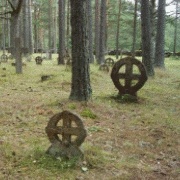Vormsi Cross
Estonia, now an independent republic, has at various times been under the rule of Danes, Swedes, Germans and finally Russians. As a result, there is diversity of cultural footprints on the island, one such example being the Vormsi Cross.

Hullo cemetery
Vormsi (German: Worms; Swedish: Ormsö) is a sparsely-populated island to the west of the Estonian mainland. The island has been inhabited since the 13th century but the cross design is much older than that.
Vormsi's main hamlet is named Hullo where we find St. Olaf's Lutheran Church. To the north is a wooded cemetery that contains over 300 circular sandstone and limestone grave markers, which date back to the 17th and 18th centuries. By that time, Vormsi had been settled by Swedish Estonians for hundreds of years, which suggests that the design reflects Swedish influence rather than Russian or German.
The Vormsi Cross differs from the more common North European Celtic Cross in that the cross arms do not extend much, if at all, beyond the circular rim. Further, all four cross members of the Vormsi Cross have the same length.
See our related page on the Sun Cross for more.

